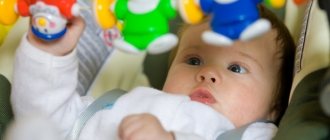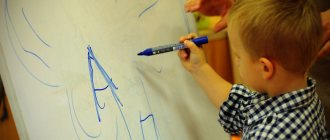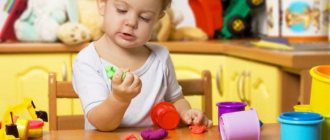How can you develop a child's abilities?
Intelligence
- First of all, you need to remember that the most intensive development of intelligence occurs between the ages of two and twelve years.
- The second rule is that abilities can be developed in different ways, but the most important and general thing is emotional support for the baby at all stages of development.
- A child's intelligence continually increases when parents give the child the opportunity to develop his own abilities, and not just control and correct what the child has done. That is, two parties are involved in the process of developing abilities - you and your child.
- Faith, calmness, patience. These three components are the three “pillars” on which the process of developing abilities rests. The child's mental abilities will grow tirelessly if the parents present him with a system of requirements and will steadily follow it and ensure that the child fulfills it. Requirements are an essential means of education. Through them, the parent tells the child how to behave in order to become successful in life. You must set your expectations once and for all.
- Encouragement is the best motivation to fulfill requirements. And increased self-esteem. Don't be afraid to upscale it. The “bar” should always be a little higher than the baby can do. Increase his self-esteem and always maintain it at a high level.
But in practice, every day:
- play different games with your child;
- do things together;
- involve him in discussing everyday issues and solving pressing family problems;
- Don’t try to immediately satisfy all the baby’s whims - leave him time and the opportunity to dream.
Creativity
To develop creativity, first of all, you need the ability to think differently, outside the box, and creatively. The ability to quickly switch from one idea to another is also important. A multilateral approach should also be developed - the ability to perform one task in different ways and look for other solutions.
As a rule, a child’s creativity causes a lot of trouble for parents. They feel uncomfortable when they don't know what to expect from their baby. But surprise and non-standard solutions are the main sign of creativity. Therefore, parents, pull yourself together, change your approach to your child and enjoy any surprise that he brings to you.
Creativity develops at an accelerated pace during two sensitive periods:
- 3-5 years (good use of story games);
- 10-12 years (development of cultural creativity).
Learning ability
The prerequisite for learning, of course, is intelligence. This means that a child’s learning ability develops best in communication with an adult.
To develop learning ability:
- ask your child questions;
- talk with your baby about everything: nature, people, events, phenomena;
- encourage your child to think and analyze, remember and be attentive;
- always expect a response from the baby, an answer, do not rush him;
- do not abandon the topic you started, the work you started - bring everything to the end, be consistent;
- Discuss with your child the results of the work done, the task completed;
- together correct the mistakes that you made together and discovered together.
Formation of a child’s motivation and abilities in the learning process
Formation of a child’s motivation and abilities in the learning process
Motivation
- this is the result of a person’s internal needs, his interests and emotions, goals and objectives, the presence of motives aimed at enhancing his activities. Motivation is an incentive to action.
Types of motivations
: external, internal, positive, negative.
External
motivation is motivation that is not related to the content of a certain activity, but is conditioned by circumstances external to the subject (for example, studying for good grades, for material reward, i.e. the main thing is not gaining knowledge, but some kind of reward).
Internal
motivation is motivation associated not with external circumstances, but with the very content of the activity.
Positive
Motivation in the process of educational activity is created in two ways.
- The first way is achieved by the formation of positive emotions (and then feelings) in relation to the object of activity, to the process of activity, to the persons with whom the child deals; this attitude is formed on the basis of the teacher’s expression of a positive attitude towards the child and the activity, acquaintance with excellent examples of activity, expression of faith in the strengths and capabilities of the child, approval, help and expression of a positive attitude towards the achieved results of his activity. From this point of view, success (given the feasible, surmountable difficulty of the task) and its public assessment are of great importance.
— The second way lies through the formation of an understanding of the meaning of activity, its personal and social significance. This understanding is achieved through a figurative story about the meaning of the activity, an accessible explanation and demonstration of a significant result, etc. If nurturing interest is limited to creating a positive attitude, then engaging in an activity will be an expression of love or duty. This kind of activity does not yet contain the cognitive nature that is most essential for interest. With the slightest change in attitude, with the disappearance of attractive objects, the child loses the desire to engage in this activity. Interest arises only in the course of properly organized activities.
Conditions
for a targeted impact on the motivational sphere of children
1. It is important to arouse a child’s interest in activities, thereby stimulating his curiosity.
2. Build the learning process on the principle of cooperation with the teacher, on the principle of pedagogical support, and this means believing in each child and his capabilities; evaluate not a person, but actions, actions; see the value not only of the result, but also of the process of interaction with the child; show attention to each child constantly, rejoicing in his independent actions, encouraging them; do not rush to conclusions; to help everyone find their “I” and preserve their uniqueness.
3. Teach children to plan their activities, determine the purpose of the activity and anticipate the result.
4. Construction of activities in such a way that in the process of work more and more new questions arise and more and more new tasks are posed, which would become inexhaustible in a given lesson.
5. Teach children to competently explain their successes and failures.
6. The teacher’s assessment increases motivation if it relates not to the child’s abilities as a whole, but to the efforts that the child makes when completing the task. The teacher needs to remember that it would be more correct to compare the child’s successes not with the successes of other children, but with his previous results.
7. Supporting children's activity, research interest and curiosity. The adult strives not only to transfer the initiative to the child, but also to support it, that is, to help realize the child’s plans, find possible mistakes, and cope with emerging difficulties.
Among the conditions that contribute to the development of cognitive activity, most authors name play and communication with adults. An adult passes on to the child not only the means and methods of cognitive activity, develops cognitive abilities, but also his attitude towards this activity. With the participation of an adult, the child has the opportunity to ask for help, correct mistakes, and choose a task of the appropriate level of difficulty. But the main thing is that the adult gives meaning to a new cognitive activity for the child, helps to maintain motivation and direct the child to solve the problem.
Thus, motivation develops in the presence of a pronounced cognitive need and the ability to work; the most important is the subordination of motives. It appears at the beginning of preschool age and then develops consistently. Along with the formation of a system of motives, the attitude towards the world around adults and peers changes, and a positive result in the development of the motivational sphere will depend on whether adults can perceive these changes, understand the changes occurring with the child and change their attitude in accordance with this.
Capabilities
– these are individual typological characteristics of a person that ensure success in activity, communication and ease of mastering them. Abilities are not limited to the knowledge, skills and abilities that a person has, but ensure their rapid acquisition, fixation and effective practical application.
Abilities are classified into:
— Natural (natural) abilities, basically biologically determined, associated with innate inclinations, formed on their basis, in the presence of elementary life experience through learning mechanisms such as conditioned reflex connections. Natural abilities are common to humans and animals, especially higher ones. For example, such elementary abilities are perception, memory, and the ability for basic communication.
— Specific human abilities that have a socio-historical origin and ensure life and development in the social environment.
Specific abilities are divided into:
— General abilities that determine a person’s success in a wide variety of activities and communication. General abilities comprise two groups – cognitive and practical.
— Cognitive abilities include, first of all, sensory, intellectual and creative. Sensory are associated with the child’s perception of objects and their qualities; they form the basis of mental development.
— Creative abilities are associated with imagination and allow the child to find original ways and means of solving problems.
— Practical abilities include: organizational, constructive and technical (spatial vision, spatial imagination, the ability to represent an object as a whole and its parts according to a plan, drawing, diagram, description, as well as the ability to independently formulate a plan that is original). These abilities are the basis; with their help, children master school subjects such as drawing, geometry, physics, chemistry, where the ability to imagine the essence of a process and the structure of a mechanism is required.
— Special abilities determine a person’s success in certain types of activity and communication, where a special kind of inclinations and their development are necessary (mathematical, technical, literary and linguistic, artistic and creative abilities, sports, musical, etc.).
Conditions for the development of abilities in preschool age:
— Features of family education. If parents care about the development of their children's abilities, then the likelihood of discovering any abilities in their children is higher. Than when children are left to their own devices.
— Involving a preschooler in different types of activities to demonstrate all his inclinations and inclinations. The child needs to try himself in all areas of activity.
— Creation of a subject-development environment.
— The correct position of an adult in communicating with children. After all, it is adults who form the child’s assessment and attitude towards their abilities and the results achieved. Therefore, when communicating with gifted children, an adult should be patient with the child’s strange ideas, show sympathy for failures, try to answer all his questions, provide maximum independence and the opportunity to do things of interest. And at the same time, it should be remembered that a gifted child is still characterized by the same age indicators as an ordinary child. Therefore, he needs to be given time for play and preschool activities in order to avoid premature maturation. The child must be helped to believe in himself and his strengths, supported on the difficult path of learning, and taught the preschooler to correctly and objectively evaluate himself and the result obtained.









